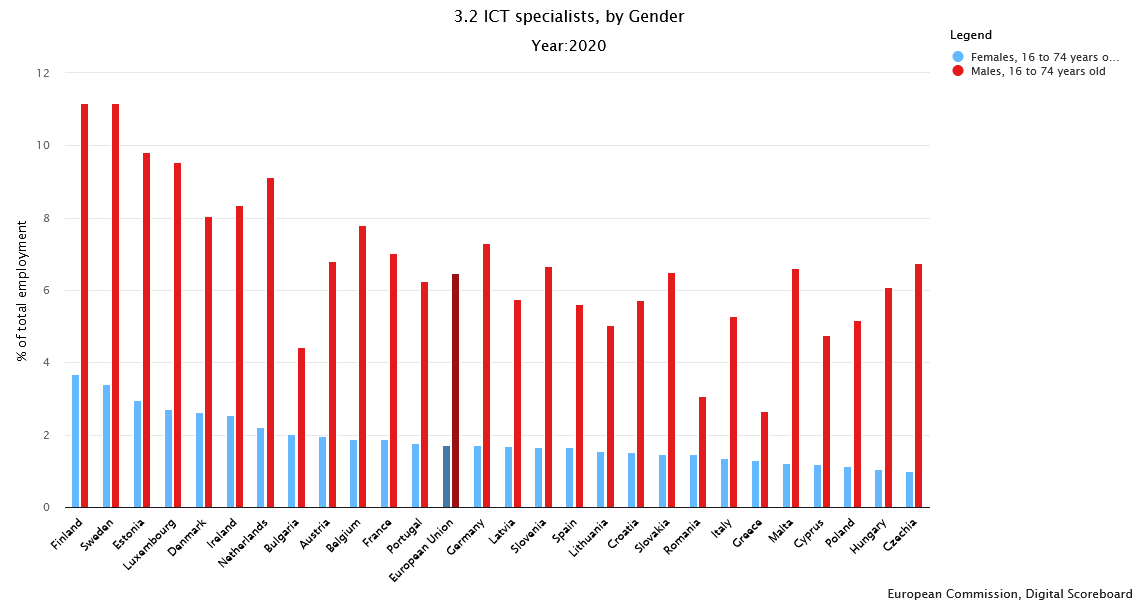If women inequality faced difficult times in IT companies before 2019, the Pandemic has broadened the gender gap even more for women working in Technological companies.
A the heart of it, we find the low interest of the system in directing young female students to technical or science careers.
Where do women stand in digital?
It is no secret that Digital Tech companies have a smaller percentage of women working within their teams than they do of men. It seems to be assumed by the population in general. But how broad this inequality in gender is might not be so obvious.
Well, 2020 EU Women in Digital Data show that whereas 12% of males worked in ICT companies in Finland, only 4% of women worked in the same sector. The gap is constant in the rest of the EU countries. This gap is called the “gender gap” or “gender inequality”.

Gender inequality: why is it important to measure?
The Internet is full of articles giving heads up about the inequality in gender in the digital sector.
We must work to include as much human diversity as possible. Otherwise, only the standard, white middle-class male will prevail. From all the existing gaps, the women’s inequality gap is the main one to reduce. After all, we are 50% of the whole world population.
Despite national conversations about gender diversity in tech, women are still underrepresented, underpaid, and often discriminated against in the tech industry, numbers show.
Women in tech statistics: The hard truths of an uphill battle by Sarah K. White
It is important to decrease the gap in technology
Inequality in gender will show up in future algorithms
An algorithm is a process or set of rules to be followed in calculations or other problem-solving operations, especially by a computer.
Algorithms tell us what we should watch next on Youtube, what news is most important to read, what posts we see on Instagram, how many hours we should exercise, etc. They are everywhere in our daily lives. About 80% of the decisions that we take in the digital world originate in algorithms.
If algorithms are programmed by only one type of person, not including the rest of different social classes, races, genders, etc, the technology we use in daily lives will only point out in one direction, not including the necessities or points of view of others, and this includes women.
In a non-equality situation, the contents will be full of gender stereotypes
The Internet is a reflection of what happens in the world. At the same time, we are also very much influenced by how the Internet shows that information to us. Gender stereotypes are at the root of the violence against women. Therefore, it is essential to work towards gender equality on the Internet.
To fight this, the Council of Europe proposes the following objectives:
- “Promote the introduction of a gender perspective into the mainstream discussion on Internet content regulation (…)
- Promote a gender perspective and equality between women and men in the electronic media.
- Promote women’s participation in the Internet industry, in particular in decision-making.
- Encourage the use of non-sexist language and images in the media, including the Internet.
- Encourage states to promote training, education, and awareness-raising action to combat sexist stereotypes.“
The gender pay gap will continue
If women are still underrpresented in IT companies, algorithm programmers will not include their reality so women’s inequality will grow bigger.
Wetopi.com
The gender pay gap or gender wage gap is the ratio of the wage of a woman to that of a man in a similar position.
In the World Economic Forum’s Global Gender Gap Report 2020 the wage gap is globally estimated at 40%. However in Europe, it can vary from 1,8% in Luxembourg to 19,2% surprisingly in…Germany!
On top of that, women encounter barriers in the most in-demand occupations.
According to the report:
“Based on data from the LinkedIn platform, women are underrepresented in six of the eight micro-clusters with the highest employment growth rate (people and culture, content production, marketing, sales, specialized project managers, data and AI, engineering and cloud computing)”
The situation is not likely to change in the short run until a real effort in reducing the gender employment gap is carried forward.
What initiatives are there to fight the gender gap of women in IT?
Luckily, many private and public initiatives encourage empowering women in technology. You can google many of them, international and local. Mentioning them all is impossible, so check out any organization in your country or city, but here you have some of them that we found interesting:
International initiatives to increase the number of Women in Tech
And how do you think, will it be possible to bridge this gap?
Don’t you have an account on Wetopi?
Free full performance servers for your development and test.
No credit card required.